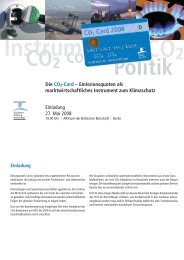Impulses for Growth and Employment through Profitable Savings in ...
Impulses for Growth and Employment through Profitable Savings in ...
Impulses for Growth and Employment through Profitable Savings in ...
Create successful ePaper yourself
Turn your PDF publications into a flip-book with our unique Google optimized e-Paper software.
sion used <strong>in</strong> this paper is based on the<br />
German Federal Agency <strong>for</strong> Statistic’s new<br />
NACE classification of national account<strong>in</strong>g.<br />
INFORGE is the economic part of the<br />
Panta Rhei model that has proved itself as<br />
an <strong>in</strong>strument <strong>for</strong> the analysis of environmental-economic<br />
relationships 14 .<br />
The INFORGE model’s strong per<strong>for</strong>mance<br />
potential is based on the INFORUM<br />
philosophy 15 that is characterised by the<br />
bottom-up <strong>and</strong> complete <strong>in</strong>tegration construction<br />
pr<strong>in</strong>ciples. The bottom-up construction<br />
pr<strong>in</strong>ciple says that each of the 59<br />
sectors of the national economy is modelled<br />
<strong>in</strong> great detail <strong>and</strong> that the national<br />
economic variables are <strong>for</strong>mulated <strong>through</strong><br />
explicit aggregation with<strong>in</strong> the model. The<br />
construction pr<strong>in</strong>ciple complete <strong>in</strong>tegration<br />
consists of a complex <strong>and</strong> simultaneous<br />
modell<strong>in</strong>g that depicts <strong>in</strong>ter-<strong>in</strong>dustrial l<strong>in</strong>kages<br />
as well as the development <strong>and</strong> distribution<br />
of <strong>in</strong>come, the government’s redistribution<br />
actions <strong>and</strong> <strong>in</strong>come use by<br />
private households <strong>for</strong> various goods <strong>and</strong><br />
services.<br />
ket, 1996-2005, <strong>in</strong>: Communication Strategies, No.<br />
28, 4th Quarter 1997, pp. 105-127; or: Meyer, B.<br />
<strong>and</strong> G. Ewerhart, Lohnsatz, Produktivität und Beschäftigung.<br />
Ergebnisse e<strong>in</strong>er Simulationsstudie mit<br />
dem disaggregierten ökonometrischen Modell<br />
INFORGE, <strong>in</strong>: Schnabl, H. (ed.), Innovation und<br />
Arbeit: Fakten – Analysen – Perspektiven, Tüb<strong>in</strong>gen<br />
1997, pp. 253-267; or: Meyer, B. <strong>and</strong> G. Ewerhart,<br />
T. Siebe, Strukturw<strong>and</strong>el, Arbeitsplätze und dienstleistungen.<br />
Analyse des sektoralen Strukturw<strong>and</strong>els<br />
<strong>in</strong> der Beschäftigung des IHK-Bezirks Münster für<br />
die Jahre 1978 bis 1996 und Prognose bis zum Jahr<br />
2000, Expertise commissioned by the Münster<br />
Chamber of Trade <strong>and</strong> Commerce, 1998; or: Meyer,<br />
B. <strong>and</strong> G. Ewerhart, T. Siebe, Tertiarisierung ohne<br />
wettbewerbsfähige Industriebasis?, <strong>in</strong>: Raum<strong>for</strong>schung<br />
und Raumordnung, No. 5/6-99; or: Meyer,<br />
B. <strong>and</strong> G. Ahlert, Die ökonomischen Perspektiven<br />
des Sports. E<strong>in</strong>e empirische Analyse für die Bundesrepublik<br />
Deutschl<strong>and</strong>, Schriftenreihe des Bundes<strong>in</strong>stituts<br />
für Sportwissenschaft, Volume 100,<br />
Schorndorf 2000; or: Lutz, C. <strong>and</strong> B. Meyer, P.<br />
Schnur, G. Zika, Projektion des Arbeitskräftebedarfs<br />
bis 2015. Modellrechnungen auf Basis des<br />
IAB/INFORGE-Modells, <strong>in</strong>: Mitteilungen aus der<br />
Arbeitsmarkt- und Berufs<strong>for</strong>schung (MittIAB),<br />
3/2002, pp. 305-326.<br />
14 Frohn, J. <strong>and</strong> P. Chen, B. Hillebr<strong>and</strong>, W. Lemke,<br />
C. Lutz, B. Meyer, M. Pullen, Wirkungen umweltpolitischer<br />
Maßnahmen. Abschätzungen mit zwei ökonometrischen<br />
Modellen, Heidelberg 2003.<br />
15 Almon, C., The INFORUM-approach to Inter<strong>in</strong>dustry<br />
Modell<strong>in</strong>g, <strong>in</strong>: Economic Systems Research<br />
3, 1991, pp. 1-7.<br />
The disaggregated structure of the<br />
INFORGE model is reflected <strong>in</strong> an enormous<br />
but consistent <strong>in</strong><strong>for</strong>mation process<strong>in</strong>g:<br />
The nearly 40,000 model equations<br />
are embedded <strong>in</strong> the fully endogenised<br />
account system of national economic account<strong>in</strong>g.<br />
The model is characterised by a<br />
very high degree of endogenisation. Exogenously<br />
specified are primarily only a few<br />
tax rates, labour supply <strong>and</strong> the global<br />
market variables of the <strong>in</strong>ternational<br />
GLODYM system that is an enhancement<br />
of the global COMPASS model 16 .<br />
INFORGE is an econometric <strong>in</strong>put-output<br />
model that can be described as an evolutionary<br />
model 17 . The behavioural equations<br />
model decision-mak<strong>in</strong>g rout<strong>in</strong>es that<br />
are not explicitly <strong>in</strong>terpreted from the optimisation<br />
behaviour of agents but are<br />
based on limited rationality. Prices are<br />
expla<strong>in</strong>ed <strong>in</strong> terms of monopolised pricesett<strong>in</strong>g<br />
behaviour. The model describes<br />
time as historical <strong>and</strong> irreversible. Capital<br />
adjustment generates path <strong>in</strong>dependence.<br />
The <strong>in</strong>put-output approach is commonly<br />
viewed as dem<strong>and</strong>-oriented modell<strong>in</strong>g.<br />
However, this is not the case <strong>for</strong><br />
INFORGE. Even if it is true that dem<strong>and</strong><br />
determ<strong>in</strong>es production <strong>in</strong> INFORGE, all<br />
goods <strong>and</strong> factor dem<strong>and</strong> variables depend<br />
upon, amongst other th<strong>in</strong>gs, relative<br />
prices, whereby the prices themselves are<br />
determ<strong>in</strong>ed by companies’ unit costs <strong>in</strong><br />
terms of a price-sett<strong>in</strong>g hypothesis. In this<br />
case, the difference vis-à-vis general balance<br />
models, <strong>in</strong> which a competitive market<br />
is modelled, is <strong>in</strong> the implicit market<br />
<strong>for</strong>m, not <strong>in</strong> the emphasis of one or the<br />
other side of the market. In other words,<br />
companies choose their sales price on the<br />
basis of their cost situation <strong>and</strong> the prices<br />
of compet<strong>in</strong>g imports. Dem<strong>and</strong> reacts to<br />
this with a decision that then determ<strong>in</strong>es<br />
the amount of production. In this way,<br />
supply <strong>and</strong> dem<strong>and</strong> elements are equally<br />
prevalent.<br />
16 Meyer, B. <strong>and</strong> K. Uno, COMPASS – E<strong>in</strong> globales<br />
Energie-Wirtschafts-modell, <strong>in</strong> : ifo-Studien, No. 45,<br />
1999, pp. 703-718. Meyer, B. <strong>and</strong> C. Lutz, Ökoeffiziente<br />
Dienstleistungen…, l.c.<br />
17 Meyer, B., Strukturanalyse, <strong>in</strong>: Herrmann-Pillath,<br />
C. <strong>and</strong> M. Lehmann-Waffenschmidt (eds.), H<strong>and</strong>buch<br />
Evolutorische Ökonomie, Berl<strong>in</strong> 2003.<br />
5




